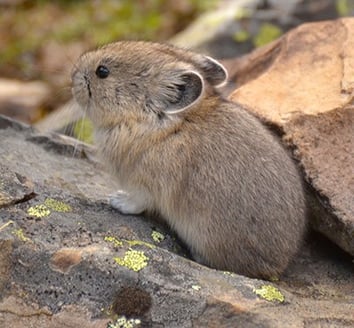Rocky Mountain Cliffs
Cliffs are prominent topographic features found around the world. From El Capitan in Yosemite to the Cliffs of Moher in Ireland, for generations humans have marveled the drastic vertical faces of cliffs. Humans have used cliffs for navigation, protection, recreation and more. Here in the Rockies, cliffs formed from tectonic activity, volcanism, weathering and erosion are found from the high alpine to the low desert. These steep, exposed rock walls provide critical shelter, breeding areas and protection for our local wildlife.
How do animals live on cliffs?
Perhaps you’ve taken a scenic drive through the mountains of Colorado and spotted a bighorn sheep scaling the side of a cliff. Maybe you’ve seen the outstretched wings of a golden eagle soaring through the sky looking for its next meal. If you’re a hiker or climber, odds are you’ve observed marmots or pikas scurrying about the rocky terrain above tree line. Without the modern anthropological luxuries of air conditioning and grocery stores, what makes the harsh cliff environment suitable habitat for the animals that call the Rockies home?
The hard, jagged, rugged turf of cliffs may not sound like a very pleasant place for us to dwell; , but cliffs provide habitat for specialized animals that rely on a specific type of environment. Many birds of prey like hawks, eagles and falcons nest on the ledges of cliffs where human disturbance is low and predator activity is unlikely. Peregrine falcons, the world’s fastest animal, hunt from high ridges before diving at speeds over 200 mph for their prey, which often includes small mammals. Smaller critters like pikas and marmots use the boulder fields below cliffs for camouflage and shelter. Their brown color and small bodies allow them to blend in with surrounding rock and hide in the cavities and pockets scattered among the bumpy landscape.
 Smaller critters like pikas and marmots use the boulder fields below cliffs
Smaller critters like pikas and marmots use the boulder fields below cliffs
for camouflage and shelter.
Larger mammals like bighorn sheep and mountain goats have specialized hooves that act as natural climbing shoes, allowing them to grip onto uneven rocky terrain and walk with ease. Their hooves and the cliff environment give them an advantage when escaping predators like mountains lions. These animals also rely on the unique shrubs, lichen and grasses that grow in rocky outcrops as a food source. But, our warm-blooded friends aren’t the only ones that use cliffs to survive. Cliffs provide hibernaculum space to mammals and reptiles that go dormant in the winter. Garter snakes, one of the few reptiles that withstand the long cold winters of Eagle County, seek refuge in naturally formed dens in the cliff environment. When active in warmer months, they take advantage of the exposed conditions of cliffs (especially south facing) to sunbathe. Since snakes and all other reptiles are ectothermic, they need the heat from external sources like the sun or warm rocks to maintain their body temperature.
Cliff ecosystems are fragile
The cliff environment is a fragile habitat imperative to the survival of birds, mammals and reptiles. Cliffs are also an amazing place for humans to recreate and enjoy nature. It is important to keep in mind how delicate these ecosystems are and to do our part to protect them. Whether hiking, rock climbing or cliff jumping, be cautious of the local wildlife and respect their habitat. Stay on designated trails and honor any trail closures for both your safety and the sanctity of our cliffs.
A mountain goat on Quandary Peak in Colorado's White River National Forest.
Katie Wareham is a Naturalist at Walking Mountains. She grew up in Maryland, where she enjoyed searching for fossils along the shoreline of a very different cliff environment at Calvert Cliffs State Park.










